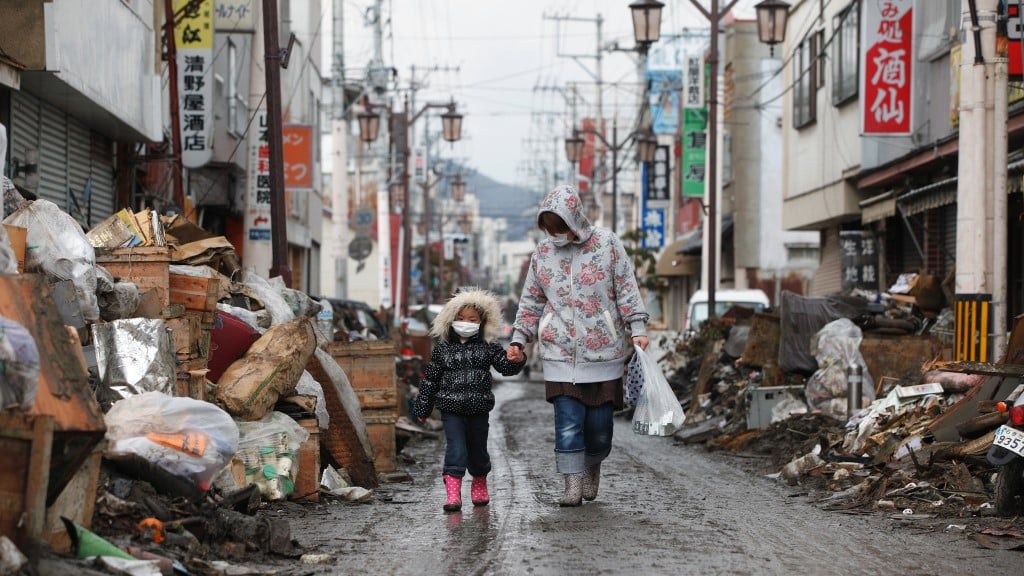A Recap of What Happened in Japan’s Devastating Earthquake, Tsunami and Nuclear Disaster

A woman and child walk through a local shopping avenue lined with rubble in Ishinomaki City, Miyagi Prefecture. ©Direct Relief
Here are some of the details of the tragedy that struck on March 11, 2011, killing nearly 16,000 people and forcing tens of thousands to leave their homes, many of them for good.
A Giant Quake, a Massive Wave
At 2:46 pm (0546 GMT) of March 11, 2011, a 9.0-magnitude underwater quake struck the Pacific seabed roughly 130 kilometres (80 miles) east of Japan’s Miyagi prefecture.
It unleashed a giant tsunami estimated to have been as high as 16.7 metres (54.8 feet), which swept away residents, destroyed homes and gutted concrete buildings.

Japan’s March 2011 tsunami swept away residents, destroyed homes and gutted concrete buildings
The Nuclear Disaster
Soon after the quake, tsunami waves swept into coastal regions, including at the Fukushima Daiichi nuclear power plant, operated by Tokyo Electric Power (TEPCO).
The power supply and reactor cooling systems at the plant were damaged, causing atomic fuel inside three of its six reactors to overheat and eventually melt down.
The government initially ordered the evacuation of residents living within three kilometres of the plant and told others to stay indoors to avoid nuclear fallout.
The evacuation order gradually expanded in the following days, a move that caused public criticism of the government’s response as slow and confusing.
Work crews scrambled, but they failed to cool the runaway reactors.
On March 12, the plant had to open a vent in a reactor to release pressure building inside. The step ejected significant radioactive materials that blanketed the vast farming and industrial region as well as the Pacific Ocean shoreline.
On the same day, a hydrogen explosion ripped through a building encasing Reactor One. It was followed by the second explosion two days later at a building housing Reactor Three. On March 15, a third explosion hit a building for Reactor Four.
Despite the blasts, the reactors remained relatively intact. But radioactive materials continued to leak.
Then-Emperor Akihito on March 16 made an emergency television address in a bid to reassure a worried public.
In December 2011, the government said it had brought the reactors to the state of “cold shutdown”, meaning that they were kept stably cool with water and emission of radioactive materials was significantly reduced.

In 2011, tsunami waves swept Japan’s Fukushima Daiichi nuclear power plant, operated by Tokyo Electric Power
The Human Cost
In all, 15,898 people died and 2,531 people remain missing after the quake and tsunami.
The Fukushima nuclear crisis itself did not directly kill anyone.
But more than 3,700 people who survived the triple calamities later died as a result of complications related to their lives in evacuation, including stress and hypertension.
Some 470,000 people were estimated to have fled their home to seek shelter in the first days of the disasters.
Even today, roughly 50,000 people remain in temporary housing, including those who are living with friends and relatives.
Eight years since the disaster, volunteers are still combing shorelines in the Pacific northeast looking for the remains of those who are missing.

Shorelines in the Pacific northeast are still combed for the remains of those who are missing after Japan’s 2011 tsunami
Clean-up and Nuclear Resistance
The government and TEPCO say it will take four decades to decommission the Fukushima reactors.
The disaster damaged farms, livestock and fishing grounds, forcing many to give up their jobs and homes.
Produce from the region is now subject to strict government checks.
The national and local governments have carried out decontamination, including removing topsoil and cleaning roads and homes in a bid to encourage people to return.
But many former residents, particularly young families, have chosen not to return to towns near the Fukushima plant because of lingering health fears.
The disaster prompted the temporary shutdown of all nuclear plants in Japan, with Prime Minister Shinzo Abe’s government pushing for them to be reopened.
But deep public resistance has meant only a handful of reactors have been restarted, with utilities in some cases deciding to scrap obsolete reactors.
